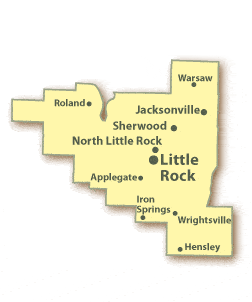 If your home or business is more than 150 feet from the nearest Comcast cable, the company will think twice before providing you with service.
If your home or business is more than 150 feet from the nearest Comcast cable, the company will think twice before providing you with service.
Pat Ulrich and her 50 neighbors in a rural subdivision in Arkansas have waited more than 15 years for Comcast or AT&T to extend broadband service to no avail, not unless they are willing to pay an installation fee of almost $50,000.
“When we evaluate prospective new build opportunities, we take into account such factors as distance from where our nearest network exists, costs associated with a proposed build-out, and number of homes and businesses that could be served. … This subdivision is many miles from our nearest plant.” Alex Horwitz, vice president of public relations for Comcast, told Arkansas Business. A nearby neighbor of Ulrich was quoted $46,000, mostly to install over 6,400 feet of fiber optic cable to connect the subdivision to Comcast’s network.

Pulaski County, Ark.
AT&T is no help either, because the homes are too far away from the phone company’s central switching office to deliver adequate internet service.
The FCC’s Connect America Fund (CAF) and other broadband funding initiatives normally might offer Ulrich and her neighbors some help, except for the fact the FCC’s broadband availability maps falsely claim the subdivision is already getting broadband service, which disqualifies it from receiving broadband expansion subsidy funding.
“We built a house in 2004 and never imagined it would take this long to get reliable broadband service,” Ulrich said.
Comcast and other cable operators did, however. Unlike phone companies that are mandated to provide basic telephone service to any customer seeking it, cable companies are allowed to choose the areas they service, typically based on population density and the costs associated with providing service. For Comcast, service extensions must meet the company’s return on investment test, and Ulrich’s subdivision failed. Horowitz claimed extending service would require Comcast to route a fiber extension through an area that “is almost all rock.”
Comcast is investing in some buildouts in its service area, but mostly to serve business parks. For residential areas, the company wants to limit the amount of cable it must install to reach a prospective customer to under 150 feet. If service is not available on your street, chances are the company will quote an installation fee running into the thousands of dollars.
Unfortunately for Ulrich, even if she managed to have the FCC correct their broadband availability map, Horwitz said Comcast has not bid for any of the FCC’s CAF projects in Arkansas.


 Subscribe
Subscribe
Verizon bid in the CAF 2 auction (rather than accepting usf funds for expansion) and is using winnings to expand FIOS to locations that were too expensive to reach.
This FCC map shows huge areas of Virginia getting gigabit, along with West Virginia, Pennsylvania, Western MA, some very small areas in RI and eastern MA.
https://www.fcc.gov/reports-research/maps/caf2-auction903-results/
This pdf shows winning bids by area. I was seriously surprised Verizon is expanding fiber using this especially in RI.
https://docs.fcc.gov/public/attachments/DA-19-126A2.pdf
And these already profitable ISPs wonder why cities and towns are fed up with sub-par internet service have decided to wire themselves instead of waiting for something g that will never come.
The residents of these subdivisions need to get in touch with realtors to determine what value would be added to their homes if they live in a cable/fiber served subdivision.
If the cost to wire the subdivision s $100,000, and there are 20 homes, is the value of each home increased by at least $5,000? If the answer is, “Yes”, then pay…
Ever home needs to have access to proper Broadband same limits and speeds that anyone city people have and take for granted. Perhaps the idea of fining telecom’s for promoting and engaging in classism, racism, and location discrimination.
Oh for gods sake. Everyone deserves? A need defined as a responsibility? Telecoms only discriminate over $’s, how much, how little. Racism? The last time I heard of someone refusing to sell a product to anyone who had $’s was in 1965. Since then there is no systemic racism except in your head. And clearly you know how to play the victim card.
According to Wikipedia utility pole spacing in urban areas is 125 feet between poles and 300 feet between poles in rural areas. That figures out to somewhere between 21 poles on the low end to 51 poles on the high end. The $50,000/6400 feet figures to $7.8125 per foot. You may think that excessive but there is probably already telephone lines on the pole. That will require make ready work to move the telephone lines down to make room for the cable companies line. The cable company has to pay for that work. Lots of attachment rules and permits involved.